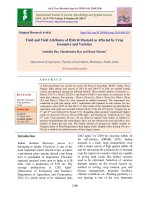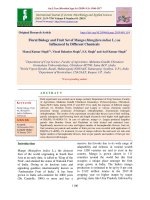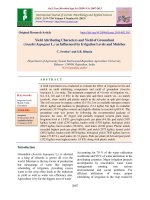Single cross hybrid of QPM maize seed production as influenced by row ratio and spacing in North Western Himalayan Region
Bạn đang xem bản rút gọn của tài liệu. Xem và tải ngay bản đầy đủ của tài liệu tại đây (235.13 KB, 6 trang )
Int.J.Curr.Microbiol.App.Sci (2020) 9(8): 1491-1496
International Journal of Current Microbiology and Applied Sciences
ISSN: 2319-7706 Volume 9 Number 8 (2020)
Journal homepage:
Original Research Article
/>
Single Cross Hybrid of QPM Maize Seed Production as Influenced by Row
Ratio and Spacing in North Western Himalayan Region
Vikas Sharma*, Anil Bhushan, Deepak Kumar, Sunil Mishra and Rajesh Kumar
Regional Agricultural Research Station, Rajouri of SKUAST-Jammu, (J&K), India
*Corresponding author
ABSTRACT
Keywords
Hybrid Maize,
QPM and Row ratio
Article Info
Accepted:
15 July 2020
Available Online:
10 August 2020
A field experiment was conducted during the kharif season of 2016 and 2017 at Regional
Agricultural Research Station, Rajouri of SKUAST-Jammu, to study the effect of row ratio
of male and female parents and Spacing on single cross QPM maize (Zea mays L.) hybrid
seed production. The experiment was laid out in FRBD design with three replications,
constituting 8 treatment combinations involving two factors viz., spacing in main plots (S1
- 60 cm x 20 cm and S2 – 75 cm x 20 cm) and four row ratios of male and female parents
(R1 – 1:2, R2 – 1:3, R3 – 1:4 and R4 – 1:5) in sub- plots of Vivek QPM- 9 i.e., VQL -2 and
VQL - 1. Row spacings S2 (75cm x 20 cm) gave significantly higher hybrid seed yield over
the row S1 (60cm x 20 cm) spacing. The same results were obtained in case of number of
cobs per plant, cob length, no of grains per cob and 100 grain weight. The higher B: C
ratio (1:2.25) was observed in case of row spacing S 2 over S1 (1:1.91). As regards to effect
of row ratio on seed yield the maximum hybrid seed yield (16.40 q / ha) was obtained in
the row ratio of male and female parents R2 (1:3), which was statistically superior to other
treatments followed by row ratio R3 (1:4). The similar trend was observed with respect to
yield attributing characters number of cobs per plant, cob length, no of grains per cob and
100 grain weight. There was no significant interaction between row ratio and spacing. As
regards the profitability of single cross hybrid seed production of QPM as influenced by
the different treatments the highest net income of ₹ 94553 and B: C ratio of 2.78 was
obtained in 1:3 ratios of male and female parents over the other row ratios i.e., 1:2, 1:4
and 1:5ratios. However the row spacing of (75cm x20 cm) was more remunerative than the
closer spacing of (60cm x20cm). The highest hybrid seed yield of single cross hybrid
maize was recorded 16.40 q / ha with row spacing of 75 cm x 20 cm. and 1:3 ratios of
male and female parents over the other ratios i.e., 1:2, 1:4 and 1:5 ratio.
Introduction
Maize (Zea mays L.) is an important cereal
crop of the world which provides nutrition as
well as phytochemial compounds for human
beings and animals. It is a third leading crop
of the world after rice and wheat and
considered as a staple food in many part of
the world. The world wide Maize trade for the
year 2020 is forecasted to reach around 167
million tons, almost unchanged from the
previous year (Anonymous 2020). The
1491
Int.J.Curr.Microbiol.App.Sci (2020) 9(8): 1491-1496
increase in world Maize production in the last
two decades is associated with intensification
in use of hybrid seed of Maize. Maize being a
C4 plant has the higher potential for synthesis
of carbohydrate. In India Maize contributes
9.7 per cent of the total food grain production
of the country. In the northern Himalayan
Union Territory of Jammu and Kashmir, it is
the second important food crop after rice and
a major food item for the tribal and hilly
population. The productivity level of Jammu
and Kashmir 1837 kg / ha is far below than
the national average 2509 kg / ha
(Anonymous 2018). In order to achieve the
goals of food and nutrition security, endeavor
must be taken to bring more and more
production area under quality protein maize
hybrids especially in the north western
Himalayan region. The adaptation of QPM
can contribute immensely to alleviation of
malnutrition and improving livelihood
security in our region. Therefore, production
of quality hybrid of maize is of paramount
importance for enhancing protein content in
daily meals of individuals and thus ensuring
them the balanced diet for their proper growth
and development. One of the prime limiting
factors in increase productivity of this crop is
unavailability of quality seed of improved
hybrids. Quality Protein Maize (QPM),
developed in the late 1960’s, contains 55 per
cent more tryptophan, 30 per cent more
lysine, 38 per cent less leucine and higher
niacin availability due to a higher tryptophan
and lower leucine content, higher calcium and
carbohydrate, and carotene utilization than
that of normal maize (Prasanna et al., 2001).
It has good kernel, taste and appearance like
normal maize. Normal maize endosperm,
consist less than 9 per cent protein which is
either deficient in two essential amino acids
or has very low level of lysine and
tryptophan. Better protein quality in QPM is
expected to help in reducing protein
malnutrition among the rural masses. It also
provides nutritionally rich feed and fodders to
poultry feed, livestock, swine and fishes. It
may be helpful in poverty alleviation
programme through less dependency of
farmers on private seed companies for seed,
easy viability of QPM cultivars hybrid seed in
the local market, high economic return to the
farmers and entrepreneurship development
among the farming community.
Crossing between two desirable inbreds as a
male and female parents and deriving F1 or
hybrid from the cross is called a single cross
hybrid. Hybrids are reckoned as best quality
seeds for high yields and wider adaptability.
Farmers mainly depend on private seed
companies for their hybrid seed requirement
which is an expansive input in the cultivation
process. Very few cultivars of QPM are
available with private seed companies. Single
cross hybrids are vigorous, uniform in height
and maturity, possess high resistance to
insect-pests and diseases and have wider
adaptability which makes them more
productive. Production of the seed of single
cross hybrid is easier in comparison to other
hybrids since it involves two inbred lines
(parents), requires less isolation and time. It
has being reported that male: female row ratio
mainly depends on the pollen shedding
ability, duration of male parent, season, area
under seed production and male: female
synchrony (Jithendra et al., 2013). Hybrid
seed production of maize crop influenced
largely
by
several
agronomic
and
management factors, among which planting
ratio, staggered sowing and row spacing are
important.
One of the basic requirements in production
of hybrid seeds is used to optimum plant
population and planting ratios of pollen parent
to seed parent to get higher seed set and yield.
The pattern of planting ratio contribute
substantially for the uniform supply of pollen
to all the seed parent rows in achieving higher
seed set and yield. An adequate availability of
1492
Int.J.Curr.Microbiol.App.Sci (2020) 9(8): 1491-1496
inter and intra row spacing is necessary for
enhancing metabolic activities of the plant
which intern influence the plant growth. This
would be achieved by efficient utilization of
biological resources such as solar energy,
water and nutrients. Plant geometry is one of
the major management aspects; which is
limiting the seed production of maize.
Optimum spacing would help in efficient
utilization of solar energy with less
competition for growth factors The poor seed
yield noticed in many maize hybrids is mainly
attributed to the nicking problem existed
between male and female parents. Even in
well synchronized plots, the seed yield was
found to be far less from expectation which
may be due to various reasons like wind
direction, velocity and availability of
insufficient viable pollens to female parent.
Therefore, one of the basic requirements in
hybrid seed production is to find out optimum
planting ratio and plant population to provide
sufficient quantity of viable pollens to the
seed parent during flowering period for
ensuring
increased
pollination
and
fertilization to obtain higher hybrid seed set
and yield. The present investigation,
therefore, was undertaken to standardize the
agro-technology for single cross hybrid seed
production of Quality Protein Maize to
evaluate the impact of row ratio of male and
female parents and spacing on single cross
maize (Zea mays L.) hybrid seed production
for optimum yield under north western
Himalayan region.
suitable row ratio of male and female parents,
effect of spacing for optimum yield and
economics of single cross maize hybrid seed
production of Quality Protein Maize under
Rajouri conditions. The experiment was laid
out in factorial randomized block design
(FRBD) with three replications in 6 m x 6 m
plots taking two spacing in main plots (S1 - 60
cm x 20 cm and S2 – 75 cm x 20 cm) and four
row ratios of male and female parents (R1 –
1:2, R2 – 1:3, R3 – 1:4 and R4 – 1:5) in subplots of Vivek QPM- 9 i.e., VQL -2 and VQL
- 1. The soil of the experimental field was
clay loam in texture with 190.4 kg/ha N, 8.4
kg/ha P2O5 and 123.2 kg/ha available K2 O
and having a pH of 7.71. The crop was grown
with the uniform fertilizer doses i.e., Nitrogen
-90 kg, P2O5 – 60 kg, K2O – 30 kg and ZnSO4
– 25 kg per hectare as per the
recommendation of the university. Insect pest
and disease management was done uniformly
in all plots. The crop was sown on 22nd of
May, 2016 and 28th of May in the year 2017,
about 20 days prior to the general sowing
time in this area to provide time isolation for
maintaining genetic purity. The tassel of the
female lines was removed as they came out
from the plant to fertilize all the seed on
female plants from the male parent.
Observations were recorded on growth
parameters, yield attributing characters and
seed yield. Pooled data for two years was
subjected to the analysis of variance for test
of significance using standard procedure
given by Gomez and Gomez (1984).
Results and Discussion
Materials and Methods
The field experiment was conducted at
research farm of Regional Agricultural
Research Station, Rajouri of SKUASTJammu situated between 33.380 north latitude
and 74.310 east longitude with altitude of
915m amsl. Experiment was carried out
during kharif 2016 and 2017 to evaluate the
The data presented in Table 1 showed that the
days to tasseling and silking tend to increase
with decrease in plant spacing however row
ratio is not significant and interaction between
spacing and row ratio is also not significant.
The maximum days to tasseling (57.5) and
silking (59.6) were recorded under the lower
row spacing (60cm x20 cm),while the lowest
1493
Int.J.Curr.Microbiol.App.Sci (2020) 9(8): 1491-1496
days to tasseling (55.7) and silking (57.8)
respectively were noted under the wider
spacing(75cm x20cm). The maturity of the
crop was also affected by the spacing narrow
the spacing earlier the maturity (97.1). Similar
findings have been made by Gaire et al
(2020).The row spacings does not affect the
barrenness per cent significantly however
male: female row ratios have significant
effect on barrenness more the parent ratio
more the barrenness. Significant variation was
observed with respect to lodging percentage
by the row spacing closer the spacing more
the lodging per cent but row ratio had no
significant effect on lodging. Both spacing
and row ratio of parents had significant effect
on shelling per cent of Maize crop.
Table.1 Effect of spacing and row ratio on days to tasseling, silking, 75 per cent dry husk,
barrenness, lodging and shelling percent of QPM
Treatments
Days to
tasseling
Days to
silking
Days to 75 %
dry husk
Barrenness
(%)
Lodging
(%)
Shelling
(%)
57.5
55.7
1..28
59.6
57.8
1.33
97.1
98.6
0.88
3.3
3.4
N.S
2.20
1.90
0.18
78.40
81.15
1.80
58.1
57.3
57.5
56.4
N.S
61.2
60.4
59.6
58.4
N.S
97.5
98.2
96.8
98.4
N.S
3.1
3.2
3.5
3.6
0.23
2.5
2.6
2.8
2.6
N.S
80.90
80.10
77.40
76.23
1.12
Spacing (cm)
S1
S2
CD (P=0.05)
Row Ratio (Male: Female)
R1
R2
R3
R4
CD (P=0.05)
Table.2 Effect of treatments on yield attributing characters, hybrid seed yield (F1) and
Economies of QPM
Treatments
No. of
Cobs /
Plant
Spacing (cm)
S1
S2
CD (P=0.05)
Row Ratio (Male: Female)
R1
R2
R3
R4
CD (P=0.05)
No. of
Grains
Cob-1
100
Grain
Wt. (g)
Hybrid seed
yield
(q ha -1)
Net
Return
(Rs. ha -1)
B:C ratio
1.33
1.39
0.12
369.31
387.20
14.63
189.29
196.35
0.06
13.23
14.74
1.10
67490
76231
---
1.91
2.25
---
1.38
1.37
1.28
1.16
0.10
413.18
411.88
372.77
335.85
29.61
193.63
196.46
182.10
180.58
0.10
13.48
16.40
13.76
12.20
1.41
69756
94553
74810
58687
---
1.97
2.78
2.18
1.69
---
1494
Int.J.Curr.Microbiol.App.Sci (2020) 9(8): 1491-1496
Perusal of pooled data presented in the Table
2 revealed significant differences in two row
spacings with S2 (75cm x 20 cm) gave
significantly higher hybrid seed yield over the
row S1 (60cm x 20 cm) spacing. The same
results were obtained in case of number of
cobs per plant, cob length, no of grains per
cob and 100 grain weight. The higher B: C
ratio (1:2.25) was observed in case of row
spacing S2 over S1 (1:1.91).The results are in
consonance with the results reported by
Enujeke (2013).
As far as the effect of row ratio on seed yield
is concerned, the results revealed maximum
hybrid seed yield (16.40 q / ha) in the row
ratio of male and female parents R2 (1:3),
which was statistically superior to other
treatments followed by row ratio R3 (1:4).
The similar trend was observed with respect
to yield attributing characters number of cobs
per plant, cob length, no of grains per cob and
100 grain weight these results confirmed the
finding of Widdicombe and Thelen (2002).
Benefit: Cost ratio analysis was also carried
out for different treatments. The results
revealed treatment R2 showed highest B: C
ratio (1:2.78).
There was no any interaction effect in row
ratio and row spacing as per the pooled data
for both the years. The study on the relative
economics and profitability of single cross
hybrid seed production of QPM as influenced
by the different treatments the maximum net
monetary returns (NMRs) of Rs. 94553 and
benefit: cost ratio of 2.78 was fetched by 1:3
ratios of male and female parents over the
other row ratios i.e., 1:2, 1:4 and 1:5ratios.
However the wider row spacing of (75cm x20
cm) gave the net returns of Rs. 76231 and
B:C ratio (2.25) which was more
remunerative than the closer spacing of (60cm
x20cm) having net return and B:C ratios of
Rs. 67490 and 1.91 respectively. The highest
hybrid seed yield of single cross hybrid maize
was recorded 16.40 q / ha with row spacing of
75 cm x 20 cm. and 1:3 ratios of male and
female parents over the other ratios i.e., 1:2,
1:4 and 1:5 ratios.
References
Anonymous.2020.Crops Prospects and Food
Situation-Quarterly Global Report No.1
of FAO: Rome, Italy
Anonymous.2018. Statistical year book India,
Ministry of statistics and programme
implementation, Government of India.
Ramhari Gaire, Chudamani Pant, Nischal
Sapkota, Rajan Dhamaniya and Tej
Narayan Bhusal. 2020.Effect of Spacing
and Nitrogen Level on Growth and
Yield of Maize (Zea mays L.) in Mid
hill of Nepal. Malaysian Journal of
Halal research Journal. 3(2):50-55
Jithendra, D.B., G.V.Basvaraju, G.Sarika &
N.Amrutha. 2013. Effect of Fertilizer
Levels and Planting Geometry on
Growth and Seed Yield of Single Cross
Maize Hybrid NAH-2049 (Nithyashree).
Global Journal of Biology, Agriculture
and Health Science. 2(3): 216-220
Enujeke E. C.2013. Effects of variety and
spacings on growth character of hybrid
maize. Asian Journal of Agriculture and
Rural Development. 3:296-310
Gomez, K.A. and Gomez, A.A. 1984.
Statistical Procedures for Agricultural
Research. 2nd ed. John Wiley and Sons,
New York.
Prasanna, B.M., Vasal, S.K., Kassahun, B.
and Singh, N.N., 2001.Quality Protein
Maize. Current Science 81:1308-1319
Widdicombe WD and Thelen KD. 2002. Row
Width and Plant Density Effects on
Corn Grain Production in the Northern
Corn Belt. Agronomy Journal 94: 10201023.
1495
Int.J.Curr.Microbiol.App.Sci (2020) 9(8): 1491-1496
How to cite this article:
Vikas Sharma, Anil Bhushan, Deepak Kumar, Sunil Mishra and Rajesh Kumar. 2020. Single
Cross Hybrid of QPM Maize Seed Production as Influenced by Row Ratio and Spacing in
North Western Himalayan Region. Int.J.Curr.Microbiol.App.Sci. 9(08): 1491-1496.
doi: />
1496
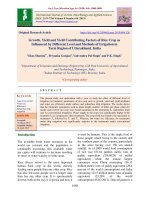
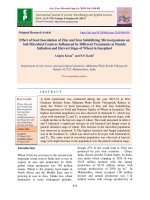
![Growth and yield of Ashwagandha [Withania somnifera (L.)] as influenced by different intercropping system in Kymore plateau of Madhya Pradesh](https://media.store123doc.com/images/document/2020_01/09/medium_vsb1578562778.jpg)
